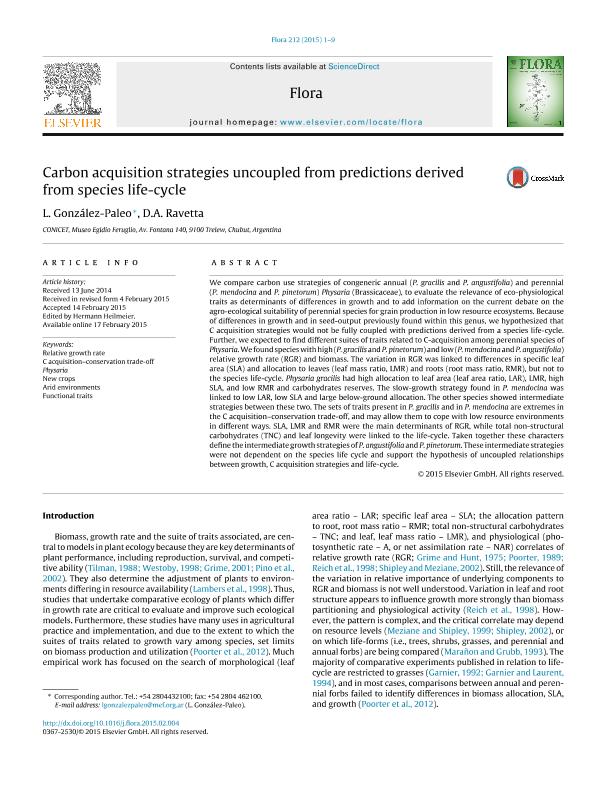Artículo
Carbon acquisition strategies uncoupled from predictions derivedfrom species life-cycle
Fecha de publicación:
03/2015
Editorial:
Elsevier Gmbh
Revista:
Flora
ISSN:
0367-2530
Idioma:
Inglés
Tipo de recurso:
Artículo publicado
Clasificación temática:
Resumen
We compare carbon use strategies of congeneric annual (P. gracilis and P. angustifolia) and perennial (P. mendocina and P. pinetorum) Physaria (Brassicaceae), to evaluate the relevance of eco-physiological traits as determinants of differences in growth and to add information on the current debate on the agro-ecological suitability of perennial species for grain production in low resource ecosystems. Because of differences in growth and in seed-output previously found within this genus, we hypothesized that C acquisition strategies would not be fully coupled with predictions derived from a species life-cycle. Further, we expected to find different suites of traits related to C-acquisition among perennial species of Physaria. We found species with high (P. gracilis and P. pinetorum) and low (P. mendocina and P. angustifolia) relative growth rate (RGR) and biomass. The variation in RGR was linked to differences in specific leaf area (SLA) and allocation to leaves (leaf mass ratio, LMR) and roots (root mass ratio, RMR), but not to the species life-cycle. Physaria gracilis had high allocation to leaf area (leaf area ratio, LAR), LMR, high SLA, and low RMR and carbohydrates reserves. The slow-growth strategy found in P. mendocina was linked to low LAR, low SLA and large below-ground allocation. The other species showed intermediate strategies between these two. The sets of traits present in P. gracilis and in P. mendocina are extremes in the C acquisition–conservation trade-off, and may allow them to cope with low resource environments in different ways. SLA, LMR and RMR were the main determinants of RGR, while total non-structural carbohydrates (TNC) and leaf longevity were linked to the life-cycle. Taken together these characters define the intermediate growth strategies of P. angustifolia and P. pinetorum. These intermediate strategies were not dependent on the species life cycle and support the hypothesis of uncoupled relationships between growth, C acquisition strategies and life-cycle.
Archivos asociados
Licencia
Identificadores
Colecciones
Articulos(SEDE CENTRAL)
Articulos de SEDE CENTRAL
Articulos de SEDE CENTRAL
Citación
González Paleo, Luciana; Ravetta, Damián Andrés; Carbon acquisition strategies uncoupled from predictions derivedfrom species life-cycle; Elsevier Gmbh; Flora; 212; 3-2015; 1-9
Compartir
Altmétricas




